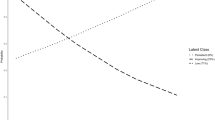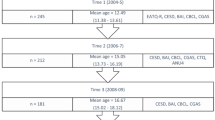Abstract
The study examined unique trajectories of ADHD severity from childhood (7–16 yo at baseline) through adulthood in a sample of ADHD, bipolar and healthy subjects. Comorbid disorders and temperament were examined as correlates of course of ADHD. N = 81 participants with an ADHD diagnosis, ascertained as a comparison group in a study of bipolar disorder (BP-I), were followed over a 10-year period. Growth mixture modeling (GMM) of ADHD severity was used to investigate trajectories of ADHD severity over 10 years. GMM revealed four trajectories in the N = 251 participants included in these analyses. A persisting high ADHD trajectory had the highest rates of comorbid major depressive disorder and oppositional defiant disorder. This persisting high ADHD group also had higher fantasy and lower persistence and self-directedness compared with those who displayed a pattern of decreasing ADHD symptoms over time. Psychopathologic features that characterize divergent trajectories of ADHD into adulthood are elucidated, and additional, larger studies are warranted.

Similar content being viewed by others
References
American Psychiatric Association (1994) Diagnostic and statistical manual of mental disorders (DSM-IV), 4th edn. American Psychiatric Association, Washington
Barbaresi WJ, Colligan RC, Weaver AL, Voigt RG, Killian JM, Katusic SK (2013) Mortality, ADHD, and psychosocial adversity in adults with childhood ADHD: a prospective study. Pediatrics 131(4):637–644. doi:10.1542/peds.2012-2354
Barkley R (2006) Attention-deficit hyperactivity disorder: a handbook for diagnosis and treatment, 3rd edn. NY Guilford Press, New York
Barkley R, DuPaul G, McMurray M (1990) Comprehensive evaluation of attention deficit disorder with and without hyperactivity as defined by research criteria. J Consult Clin Psychol 58(6):775–789. doi:10.1037/0022-006X.58.6.775
Barkley R, Fischer M, Smallish L, Fletcher K (2002a) The persistence of attention-deficit/hyperactivity disorder into young adulthood as a function of reporting source and definition of disorder. J Abnorm Psychol 111(2):279–289
Barkley R, Murphy K, Dupaul G, Bush T (2002b) Driving in young adults with attention deficit hyperactivity disorder: knowledge, performance, adverse outcomes, and the role of executive functioning. J Int Neuropsychol Soc 8(5):655–672. doi:10.1017/S1355617702801345
Barkley R, Murphy KR, Fischer M (2008) Adult ADHD: what the science says. Guilford, New York
Biederman J, Faraone SV, Keenan K, Benjamin J, Krifcher B, Moore C et al (1992) Further evidence for family-genetic risk factors in attention deficit hyperactivity disorder. Patterns of comorbidity in probands and relatives psychiatrically and pediatrically referred samples. Arch Gen Psychiatry 49(9):728–738. doi:10.1001/archpsyc.1992.01820090056010
Biederman J, Milberger S, Faraone SV, Kiely K, Guite J, Mick E, Ablon S, Warburton R, Reed E (1995) Family-environment risk factors for attention-deficit hyperactivity disorder: a test of Rutter’s indicators of adversity. Arch Gen Psychiatry 52(6):464–470. doi:10.1001/archpsyc.1995.03950180050007
Biederman J, Petty C, Monuteaux M, Fried R, Byrne D, Mirto T, Spencer T, Wilens T, Faraone S (2010a) Adult psychiatric outcomes of girls with attention deficit hyperactivity disorder: 11-year follow-up in a longitudinal case–control study. Am J Psychiatry 167(4):409–417. doi:10.1176/appi.ajp.2009.09050736
Biederman J, Petty CR, Evans M, Small J, Faraone SV (2010b) How persistent is ADHD? A controlled 10-year follow-up study of boys with ADHD. Psychiatry Res 177(3):299–304. doi:10.1016/j.psychres.2009.12.010
Biederman J, Petty CR, Clarke A, Lomedico A, Faraone SV (2011) Predictors of persistent ADHD: an 11-year follow-up study. J Psychiatr Res 45(2):150–155. doi:10.1016/j.jpsychires.2010.06.009
Bird H, Canino G, Rubiostipec M, Ribera JC (1987) Further measures of the psychometric properties of the Childrens Global Assessment Scale. Arch Gen Psychiatry 44(9):821–824. doi:10.1001/archpsyc.1987.01800210069011
Bird H, Gould M, Staghezza B (1992) Aggregating data from multiple informants in child psychiatry epidemiological research. J Am Acad Child Adolesc Psychiatry 31(1):78–85. doi:10.1097/00004583-199201000-00012
Brown RT, Borden KA (1986) Hyperactivity at adolescence: some misconceptions and new directions. J Clin Child Psychol 15(3):194–209. doi:10.1207/S15374424jccp1503_1
Cheung CH, Rijdijk F, McLoughlin G, Faraone SV, Asherson P, Kuntsi J (2015) Childhood predictors of adolescent and young adult outcome in ADHD. J Psychiatr Res 62:92–100. doi:10.1016/j.jpsychires.2015.01.011
Faraone SV, Biederman J, Mick E (2006) The age-dependent decline of attention deficit hyperactivity disorder: a meta-analysis of follow-up studies. Psychol Med 36(2):159–165. doi:10.1017/s003329170500471x
Geller B, William M, Zimerman B, Frazier J (1996) Washington University in St. Louis Kiddie Schedule for Affective Disorders and Schizophrenia (WASH-U-KSADS). Washington University in St Louis, St Louis
Geller B, Warner K, Williams M, Zimerman B (1998) Prepubertal and young adolescent bipolarity versus ADHD: assessment and validity using the WASH-U-KSADS, CBCL and TRF. J Affect Disord 51(2):93–100. doi:10.1016/S0165-0327(98)00176-1
Geller B, Zimerman B, Williams M, Bolhofner K, Craney JL, DelBello MP, Soutullo C (2001) Reliability of the Washington University in St. Louis Kiddie Schedule for Affective Disorders and Schizophrenia (WASH-U-KSADS) mania and rapid cycling sections. J Am Acad Child Adolesc Psychiatry 40(4):450–455. doi:10.1097/00004583-200104000-00014
Geller B, Zimerman B, Williams M, Delbello MP, Bolhofner K, Craney JL, Frazier J, Beringer L, Nickelsburg MJ (2002) DSM-IV mania symptoms in a prepubertal and early adolescent bipolar disorder phenotype compared to attention-deficit hyperactive and normal controls. J Child Adolesc Psychopharmacol 12(1):11–25. doi:10.1089/10445460252943533
Geller B, Tillman R, Craney JL, Bolhofner K (2004) Four-year prospective outcome and natural history of mania in children with a prepubertal and early adolescent bipolar disorder phenotype. Arch Gen Psychiatry 61(5):459–467. doi:10.1001/archpsyc.61.5.459
Gittelman R, Mannuzza S, Shenker R, Bonagura N (1985) Hyperactive boys almost grown up: I. Psychiatric status. Arch Gen Psychiatry 42(10):937–947. doi:10.1001/archpsyc.1985.01790330017002
Halperin J, Healey D (2011) The influences of environmental enrichment, cognitive enhancement, and physical exercise on brain development: can we alter the developmental trajectory of ADHD? Neurosci Biobehav Rev 35(3):621–634. doi:10.1016/j.neubiorev.2010.07.006
Halperin J, Trampush J, Miller C, Marks D, Newcorn J (2008) Neuropsychological outcome in adolescents/young adults with childhood ADHD: profiles of persisters, remitters and controls. J Child Psychol Psychiatry 49(9):958–966. doi:10.1111/j.1469-7610.2008.01926.x
Hart E, Lahey B, Loeber R, Applegate B, Frick P (1995) Developmental change in attention-deficit hyperactivity disorder in boys: a four-year longitudinal study. J Abnorm Child Psychol 23(6):729–749. doi:10.1007/BF01447474
Hinshaw SP, Owens EB, Zalecki C, Huggins SP, Montenegro-Nevado AJ, Schrodek E, Swanson EN (2012) Prospective follow-up of girls with attention-deficit/hyperactivity disorder into early adulthood: continuing impairment includes elevated risk for suicide attempts and self-injury. J Consult Clin Psychol 80(6):1041–1051. doi:10.1037/a0029451
Hollingshead AB (1976) Four Factor Index of social status. Yale University Department of Sociology, New Haven
Karam RG, Breda V, Picon FA, Rovaris DL, Victor MM, Salgado CAI, Caye A (2015) Persistence and remission of ADHD during adulthood: a 7-year clinical follow-up study. Psychol Med 45(10):2045–2056
Kessler RC, Ormel J, Petukhova M, McLaughlin KA, Green JG, Russo LJ, Ustun TB (2011) Development of lifetime comorbidity in the World Health Organization world mental health surveys. Arch Gen Psychiatry 68(1):90–100. doi:10.1001/archgenpsychiatry.2010.180
Lahey B, McBurnett K, Loeber R (2000) Are attention-deficit/hyperactivity disorder and oppositional defiant disorder developmental precursors to conduct disorder? In: Sameroff A, Lewis M, Miller S (eds) Handbook of developmental psychopathology. Plenum, New York, pp 431–446
Lara C, Fayyad J, de Graaf R, Kessler RC, Aguilar-Gaxiola S, Angermeyer M, Demytteneare K, de Girolamo G, Haro JM, Jin R (2009) Childhood predictors of adult attention-deficit/hyperactivity disorder: results from the World Health Organization World Mental Health Survey Initiative. Biol Psychiatry 65(1):46–54. doi:10.1016/j.biopsych.2008.10.005
Loney J, Kramer J, Milich RS (1981) The hyperactive child grows up: predictors of symptoms, delinquincy and achievement at follow-up. In: Gadow KD, Loney J (eds) Psychosocial aspects of drug treatment for hyperactivity. Westview Press, Boulder, pp 381–416
Luby J, Svrakic D, McCallum K, Przybeck T, Cloninger C (1999) The Junior Temperament and Character Inventory: preliminary validation of a child self-report measure. Psychol Rep 84(3 Pt 2):1127–1138. doi:10.2466/pr0.1999.84.3c.1127
Lynskey MT, Fergusson DM (1995) Childhood conduct problems, attention deficit behaviors, and adolescent alcohol, tobacco, and illicit drug use. J Abnorm Child Psychol 23(3):281–302. doi:10.1007/BF01447558
Mannuzza S, Klein RG, Bessler A, Malloy P, LaPadula M (1993) Adult outcome of hyperactive boys: educational achievement, occupational rank, and psychiatric status. Arch Gen Psychiatry 50(7):565–576. doi:10.1001/archpsyc.1993.01820190067007
Mannuzza S, Klein RG, Bessler A, Malloy P, LaPadula M (1998) Adult psychiatric status of hyperactive boys grown up. Am J Psychiatry 155(4):493–498
Mannuzza S, Klein RG, Moulton JL (2003) Persistence of attention-deficit/hyperactivity disorder into adulthood: What have we learned from the prospective follow-up studies? J Atten Disord 7(2):93–100. doi:10.1177/108705470300700203
Miller CJ, Miller SR, Newcorn JH, Halperin JM (2008) Personality characteristics associated with persistent ADHD in late adolescence. J Abnorm Child Psychol 36(2):165–173. doi:10.1007/S10802-007-9167-7
Moffitt TE, Houts R, Asherson P, Belsky DW, Corcoran DL, Hammerle M, Poulton R (2015) Is Adult ADHD a Childhood-Onset Neurodevelopmental Disorder? Evidence From a Four-Decade Longitudinal Cohort Study. Am J Psychiatry 172(6):967–977
Molina BSG, Hinshaw SP, Swanson JM, Arnold LE, Vitiello B, Jensen PS, Houck PR (2009) The MTA at 8 Years: prospective follow-up of children treated for Combined-Type ADHD in a multisite study. J Am Acad Child Adolesc Psychiatry 48(5):484–500. doi:10.1097/CHI.0b013e31819c23d0
Monuteaux MC, Mick E, Faraone SV, Biederman J (2010) The influence of sex on the course and psychiatric correlates of ADHD from childhood to adolescence: a longitudinal study. J Child Psychol Psychiatry 51(3):233–241. doi:10.1111/j.1469-7610.2009.02152.x
Nigg JT, Butler KM, Huang-Pollock CL, Henderson JM (2002) Inhibitory processes in adults with persistent childhood onset ADHD. J Consult Clin Psychol 70(1):153–157. doi:10.1037/0022-006X.70.1.153
Pingault J-B, Tremblay RE, Vitaro F, Carbonneau R, Genolini C, Falissard B, Côté SM (2011) Childhood trajectories of inattention and hyperactivity and prediction of educational attainment in early adulthood: a 16-year longitudinal population-based study. Am J Psychiatry 168(11):1164–1170. doi:10.1176/appi.ajp.2011.10121732
Puig-Antich J, Ryan N (1986) The schedule for affective disorders and schizophrenia for school-age children (Kiddie-SADS)-1986. Western Psychiatric Institute and Clinic, Pittsburgh
Rasmussen P, Gillberg C (2000) Natural outcome of ADHD with developmental coordination disorder at age 22 years: a controlled, longitudinal, community-based study. J Am Acad Child Adolesc Psychiatry 39(11):1424–1431. doi:10.1097/00004583-200011000-00017
Rettew DC, Copeland W, Stanger C, Hudziak JJ (2004) Associations between temperament and DSM-IV externalizing disorders in children and adolescents. J Dev Behav Pediatr 25(6):383–391. doi:10.1097/00004703-200412000-00001
Roberts BW, DelVecchio WF (2000) The rank-order consistency of personality traits from childhood to old age: a quantitative review of longitudinal studies. Psychol Bull 126(1):3–25. doi:10.1037/0033-2909.126.1.3
Shaffer D, Gould MS, Brasic J, Ambrosini P, Fisher P, Bird H, Aluwahlia S (1983) A Childrens Global Assessment Scale (CGAS). Arch Gen Psychiatry 40(11):1228–1231. doi:10.1001/archpsyc.1983.01790100074010
Shiner RL, Buss KA, McClowry SG, Putnam SP, Saudino KJ, Zentner M et al (2012) What is temperament now? Assessing progress in temperament research on the twenty-fifth anniversary of Goldsmith et al. Child Dev Perspect 6(4):436–444. doi:10.1111/j.1750-8606.2012.00254.x
Spencer TJ, Biederman J, Mick E (2007) Attention-deficit/hyperactivity disorder: diagnosis, lifespan, comorbidities, and neurobiology. J Pediatr Psychol 32(6):631–642. doi:10.1093/jpepsy/jsm005
Taylor E, Sandberg S, Thorley G, Giles S (1991) The epidemiology of childhood hyperactivity, vol 33. Institute of Psychiatry/Oxford University Press, Oxford
Turgay A, Goodman DW, Asherson P, Lasser RA, Babcock TF, Pucci ML, Barkley R (2012) Lifespan persistence of ADHD: the life transition model and its application. J Clin Psychiatry 73(2):192–201. doi:10.4088/JCP.10m06628
Uchida M, Spencer TJ, Faraone SV, Biederman J (2015) Adult outcome of ADHD an overview of results from the MGH longitudinal family studies of pediatrically and psychiatrically referred youth with and without ADHD of both sexes. J Atten Disord. doi:10.1177/1087054715604360
Weiss G, Hechtman L, Milroy T, Perlman T (1985) Psychiatric status of hyperactives as adults: a controlled prospective 15-year follow-up of 63 hyperactive children. J Am Acad Child Psychiatry 24(2):211–220. doi:10.1016/S0002-7138(09)60450-7
Wender EH (1995) Attention-deficit hyperactivity disorders in adolescence. J Dev Behav Pediatr 16(3):192–195. doi:10.1097/00004703-199506000-00008
Wilens T, Upadhyaya H (2007) Impact of substance use disorder on ADHD and its treatment. J Clin Psychiatry 68(8):e20
Wilens T, Biederman J, Spencer TJ (2002) Attention deficit/hyperactivity disorder across the lifespan. Annu Rev Med 53:113–131. doi:10.1146/annurev.med.53.082901.103945
Wilson JM, Marcotte AC (1996) Psychosocial adjustment and educational outcome in adolescents with a childhood diagnosis of Attention Deficit Disorder. J Am Acad Child Adolesc Psychiatry 35(5):579–587. doi:10.1097/00004583-199605000-00012
Funding
This research was supported by the National Institutes of Health: DA000357; DA023668; DA032573; MH064769; MH53063, and MH57451.
Author information
Authors and Affiliations
Corresponding author
Ethics declarations
Conflict of interest
The author(s) declared no potential conflicts of interest with respect to the research, authorship, and/or publication of this article.
Rights and permissions
About this article
Cite this article
Tandon, M., Tillman, R., Agrawal, A. et al. Trajectories of ADHD severity over 10 years from childhood into adulthood. ADHD Atten Def Hyp Disord 8, 121–130 (2016). https://doi.org/10.1007/s12402-016-0191-8
Received:
Accepted:
Published:
Issue Date:
DOI: https://doi.org/10.1007/s12402-016-0191-8




